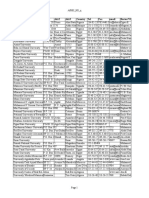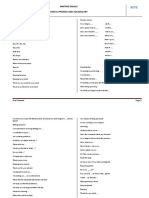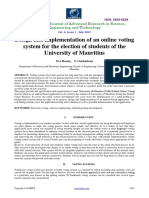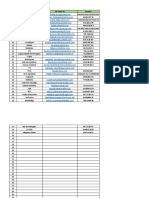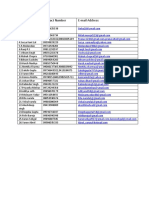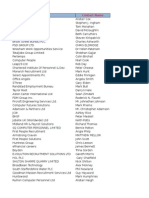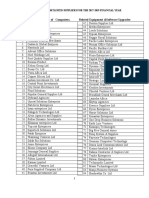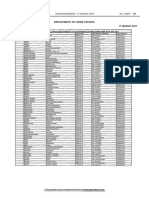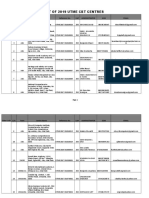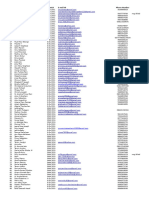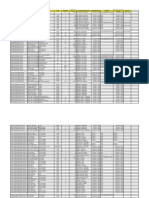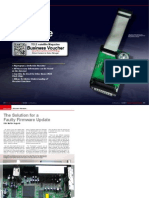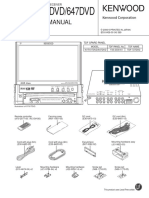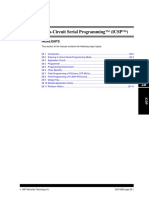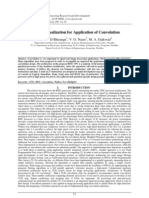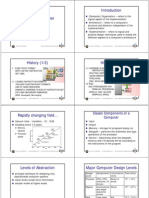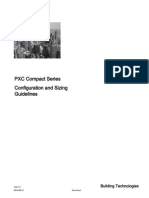PMIS Notes
Uploaded by
levina akinyiPMIS Notes
Uploaded by
levina akinyiPMIS
PMIS stands for "Project Management Information System."
It is a computer-based system used to manage and organize information related to a specific
project or set of projects.
PMIS typically includes tools and functionality for project planning, scheduling, resource
allocation, communication, and reporting.
It is used by project managers and team members to track progress, identify and resolve issues,
and ensure successful completion of the project.
A project is the work performed by an organization one time to produce a unique outcome.
Introduction to Information Systems
An information system is a set of interconnected components that collect, process, store, and
distribute information to support decision making and control in an organization.
It consists of organized combination of people, hardware, software, communications networks,
and data resources that collects data, transforms it, and disseminates information.
Meaning of Terms in Information Systems
There are many terms and concepts used in the field of Information Systems (IS) that have
specific meanings. Some common terms and their definitions include:
Information Technology (IT): The use of computers, software, networks, and other digital
technologies to process, store, and transmit information.
Business Intelligence (BI): The use of data, information systems, and technologies to support
decision-making and strategic planning in an organization.
Cloud Computing: The delivery of computing services (including storage, databases,
networking, software, analytics, and intelligence) over the internet (“the cloud”) to offer
faster innovation, flexible resources, and economies of scale
Cyber security: The practice of protecting computers, networks, and digital information from
unauthorized access, use, disclosure, disruption, modification, or destruction.
Artificial Intelligence (AI): The simulation of human intelligence processes by computer
systems.
Internet of Things (IoT): The interconnectedness of everyday devices, such as smartphones,
appliances, and vehicles, through the internet.
Process: A set of logically related tasks performed to achieve a defined outcome.
System: A set of elements or components that interact to accomplish goals.
Computer Based Information System: An Information System (IS) can be any organized
combination of people, hardware, software, communications networks, data resources, and
policies and procedures that stores, retrieves, transforms, and disseminates information in an
organization.
Data: Raw facts and figures that can be processed to produce useful information.
Information: Data that has been processed and organized in a meaningful way.
The value of Information is directly linked to how it helps decision makers achieve their
organization’s goals.
PMIS Notes By Mr. Namanda Kitale National Polytechnic Page 1
Qualities of Good Information
Good information is characterized by several key qualities, including:
(i) Accurate: The information is free from errors and is reliable.
(ii) Relevant: The information is appropriate for the purpose for which it is being used and
addresses the needs of the intended audience.
(iii) Timely: The information is available when it is needed.
(iv) Complete: The information contains all the necessary details and is not missing any
important information.
(v) Consistent: The information is presented in a consistent format and is easy to understand.
(vi) Accessible: The information is easily located and retrievable.
(vii) Understandable: The information is presented in a clear and understandable manner.
(viii) Verifiable: The information can be independently verified and confirmed.
(ix) Credible: The information is coming from a trustworthy and reliable source.
Having these qualities in information is important because it ensures that the information is
useful, trustworthy and reliable which in turn helps in decision making process.
Major Components of an Information System
Hardware
The hardware component of an IS refers to physical parts of a computer or other computing
devices.
Software
it refers to the Instructions that tell the hardware what to do.
They are represented by icons as graphical images on the desktop after installation.
Networks
These are Computing devices that communicate with each other to share information and
resources.
Database
Refers to software that enables storage and retrieval of related information about entities or
objects.
People
These are users who combine the hardware, software, data, and networks with procedures to
produce quality information.
Procedures
Procedures are the strategies, policies, methods and rules for using computer based information
systems.
The components of an information system work together to provide quality information by:
Collecting the Information
Processing the Information
Storing the Information
Retrieving the Information
Disseminating or Sharing the Information
PMIS Notes By Mr. Namanda Kitale National Polytechnic Page 2
Manual Systems and Computerized Systems
Manual systems and computerized systems are both methods used to process and organize
information, but they differ in their methods of operation and the technology they use.
Manual Systems
Manual systems are information processing systems that are done by hand, rather than by
computer.
They rely on physical records, such as paper documents, and are typically processed by human
operators.
Benefits of Manual Systems
Manual systems have several benefits over computerized systems, including:
Cost-effective: Generally require less initial investment and ongoing costs than computerized
systems. They do not require expensive hardware or software, and they can be implemented
and maintained with minimal technical expertise.
Simple to use: Manual systems are often easy to understand and use, even for individuals
with limited computer skills. They do not require specialized training or technical
knowledge.
Reliable: Manual systems are not dependent on electricity or internet access, which means
they can still be used in case of power outages or internet disruptions.
Less vulnerable to hacking: Manual systems are less vulnerable to hacking and cyber-attacks
compared to computerized systems, as they do not have an internet connection, meaning they
cannot be accessed remotely.
Backup: Manual systems often have a physical backup, which can be useful in case of loss of
digital records.
Limitations of Manual system
Manual systems have several limitations compared to computerized systems, including:
Inefficiency: Manual systems can be time-consuming and labor-intensive, especially when
dealing with large amounts of data or complex processes. They also require a significant
amount of human effort to process, store, and retrieve information.
Limited storage capacity: Manual systems have a limited storage capacity, which can make it
difficult to keep track of large amounts of information. They also require a significant
amount of physical space to store paper records.
Prone to errors: Manual systems are prone to human errors, such as mistakes in data entry,
calculation errors, or the misplacement of physical records. These errors can be difficult to
detect and correct, and can compromise the accuracy and reliability of the information.
Limited data processing capabilities: Manual systems lack the advanced data processing
capabilities of computerized systems, such as the ability to perform complex calculations,
sort and filter data, or generate reports.
Limited accessibility: Manual systems can be difficult to access, especially if records are
stored in different locations or if they are not properly organized. This can make it difficult to
quickly retrieve the information you need.
Limited security: Manual systems lack the security features of computerized systems, and
physical records are more susceptible to loss, damage, or unauthorized access.
PMIS Notes By Mr. Namanda Kitale National Polytechnic Page 3
Overall, manual systems can be useful in certain situations, but they have limitations that can
make them less efficient and less effective than computerized systems. In many cases, it may be
more beneficial to use a computerized system in order to overcome these limitations and improve
the efficiency and effectiveness of information processing.
Computerized Systems
Computerized systems are information processing systems that use computers and digital
technology to process, store, and transmit information.
They rely on electronic records, such as digital files and databases, and are typically processed
by computer software. Examples of computerized systems include: electronic filing systems,
accounting software, and word processing software.
Benefits of Computerized Systems
Computerized systems offer several benefits over manual systems, including
Efficiency: Computerized systems can process and store large amounts of data quickly and
accurately, reducing the need for manual data entry and calculations.
Speed: Computerized systems can process, store, and retrieve information quickly, making it
easy to access the data you need when you need it.
Increased storage capacity: Computerized systems have virtually unlimited storage capacity,
making it easy to keep track of large amounts of information.
Reduced errors: Computerized systems are less prone to human errors, as they rely on
computer algorithms and software to process and store information.
Better accessibility: Computerized systems can be accessed remotely and securely, making it
easy to share information with others or work on the same data from different locations.
Advanced data processing capabilities: Computerized systems have advanced data
processing capabilities, such as the ability to perform complex calculations, sort and filter
data, or generate reports.
Increased security: Computerized systems have built-in security features, such as password
protection and encryption, which can help protect sensitive information from unauthorized
access or hacking.
Scalability: Computerized systems can be easily scaled to meet the growing data processing
needs of an organization.
Integration: Computerized systems can be easily integrated with other systems and software,
allowing for streamlined workflows and increased collaboration.
Automation: Computerized systems can automate repetitive tasks, saving time, increasing
efficiency, and reducing the potential for human error.
Limitations of Computerized Systems
High capital expenditure – The amount of money required to invest in a computerized
system can be expensive to individuals and smaller companies. Much money is required to
purchase the system devices, maintain them and also train the users of the system.
Worker lay off – Computerized systems take the place of some workers.
PMIS Notes By Mr. Namanda Kitale National Polytechnic Page 4
System Failure – If something happens to the hardware or software that makes it stop
functioning, then the information cannot be accessed until the required hardware or software
has been repaired or replaced.
Computer Crime and Information theft – Computer Hackers and unauthorized users can use
illegal means of getting access to secured information.
DATA CAPTURE AND PROCESSING
Data capture and processing refer to the methods used to collect, store, and manipulate data in
order to extract useful information.
Data Capture
Data capture refers to the process of collecting data from various sources, such as surveys,
experiments, and databases.
This data can be in the form of text, numbers, images, or other types of information.
Data capture can be done manually, through the use of paper forms or handwritten notes, or it
can be done electronically, through the use of computer software or online tools.
1. Manual Data Capture:
In manual data capture process, the data is entered manually by an operator using input devices
like keyboard, touch screens, mouse etc. for keying in data in the form of figures or text into
particular software such as Excel or any other data or word processing program.
This method of data collection is labor intensive, time consuming and so businesses find it
efficient to migrate to automated methods of data capture.
However, the manual method is not totally extinct and still finds application in many business
processes. Briefly, the methods of manual data capture include using:
o Mouse
o Graphics tablet
o Keyboard
o Touch-screen – e.g. PDA
o Tracker ball
2. Automated Data Capture:
Automated data capture involves the use of computerized technology to capture data.
This method has a high initial cost on account of the initial investment required as for instance,
the purchase of technology but as the project proceeds, is found to lower the operating costs
significantly on account of low manpower requirement. Further, with the majority of data today
existing in electronic forms, the cost of using such automated technology has also reduced.
Automated data capture includes the use of different technologies such as OCR, ICR, OMR and
others, which are individually described here.
PMIS Notes By Mr. Namanda Kitale National Polytechnic Page 5
a) Optical Character Recognition (OCR):
OCR technology is used to convert different types of machine-printed documents including
image files, PDF files or scanned paper documents, into searchable and editable data.
b) Intelligent Character Recognition (ICR):
ICR technology helps to recognize and capture handwritten an printed characters from image
files. As handwritten text varies significantly, so ICR is less accurate and complicated as
compared to other technologies. However, the technology evolves continuously by itself and as
the number of samples processed increases, the accuracy increases. This self-learning process
differentiates it from others and gives it the name of ‘intelligent’.
c) Optical Mark Reading (OMR):
OMR technology is used to capture human marked data from documents such as forms and
surveys. The technology has the capacity to differentiate between marked and unmarked boxes
and so, is used for capturing data through boxes that are checked manually on documents.
d) Magnetic Ink character Recognition (MICR):
It is a data capture technology capable of recognizing characters. It involves the recognition of
specially formatted characters that are printed in magnetic ink, by a machine. The technology is
mainly used by banking industry to speed up the processing of cheques and other documents.
The added advantage of this method is that humans can also read the data as well.
e) Magnetic Stripe Cards:
Magnetic stripe cards store data using magnetic properties of certain materials. They possess
stripes of iron-based magnetic materials on the card. They are used for electronically storing
particular numbers related to credit cards, identity cards and they enable automated data transfer
when they are swiped in magnetic readers.
f) Smart-Cards:
Smart cards are pocket-sized cards with embedded integrated circuits. They can function on
contact or can be contactless. They contain more memory than magnetic cards and can be used
for data related to personal identification, authentication, biometrics etc. Upon interaction with
suitable reading devices they enable automated information transfer and data access.
g) Web-Data Capture:
Data capture from web involves the capture of data from electronic forms through internet or
intranet.
h) Voice- Recognition:
Voice recognition is the process of converting speech into text. The text can be simple text or can
be a set of commands. It finds application in dictation systems, small controlling systems and
certain processes of data entry and word-processing environment.
A suitable selection of a data capture tool is bound to make the business process resource-
efficient, cost-effective and time saving. While knowledge of these different methods of data
capture would certainly help businesses to decide on a strategy that best suits them.
Data Processing
Data processing refers to the process of transforming raw data into useful information. This can
include tasks such as data entry, data cleaning, data validation, data analysis, and data
visualization. Data processing can be done manually, mechanically or it can be done
electronically.
PMIS Notes By Mr. Namanda Kitale National Polytechnic Page 6
Electronic Data Processing
Electronic Data Processing (EDP) refers to the use of computer systems to collect, process, store,
and manipulate data in order to extract useful information.
EDP systems are designed to automate data processing tasks and make it easier to manage large
amounts of data.
EDP systems can be used for a variety of purposes, such as:
Automating data entry and validation tasks
Storing and managing large amounts of data
Analyzing data to discover patterns and insights
Generating reports and visualizations to support decision-making
Automating repetitive tasks
Making it easier to share and collaborate on data
EDP Methods
Electronic Data Processing (EDP) methods refer to the techniques and technologies used to
process, store, and manipulate data in order to extract useful information.
Some common EDP methods include:
Batch Processing: This method involves collecting data in batches, processing it in one go,
and then storing the results for later use. Batch processing is often used for tasks such as
payroll processing, billing, and inventory management.
Real-time Processing: This method involves processing data as it is received, in real-time.
Real-time processing is often used for tasks such as monitoring systems, financial
transactions, and sensor data.
Online Processing: This method involves processing data through an online interface, such
as a web application. Online processing is often used for tasks such as online shopping, e-
banking, and social media.
Cloud Processing: This method involves using cloud-based services to process, store, and
manage data. Cloud processing is often used to process large amounts of data, to automate
repetitive tasks, and to collaborate on data.
Artificial Intelligence (AI) and Machine Learning (ML): These methods involve using
advanced algorithms and statistical models to process and analyze data. AI and ML are often
used for tasks such as image and speech recognition, natural language processing, and
predictive analytics.
Data Warehousing and Data Mining: These methods involve storing and managing large
amounts of data, and then using specialized software to extract useful information from it.
Data warehousing and data mining are often used for tasks such as customer segmentation,
market analysis, and fraud detection.
The choice of EDP method will depend on the specific needs and requirements of the
organization or individual, as well as the type and volume of data being processed.
PMIS Notes By Mr. Namanda Kitale National Polytechnic Page 7
Advantages of EDP
(a) Speed: EDP systems can process and store large amounts of data quickly and accurately,
reducing the need for manual data entry and calculations. They can also automate repetitive
tasks, freeing up time for more important work.
(b) Increased storage capacity: EDP systems have virtually unlimited storage capacity, making
it easy to keep track of large amounts of information.
(c) Reduced errors: EDP systems are less prone to human errors, as they rely on computer
algorithms and software to process and store information.
(d) Better accessibility: EDP systems can be accessed remotely and securely, making it easy to
share information with others or work on the same data from different locations.
(e) Increased security: EDP systems have built-in security features, such as password protection
and encryption, which can help protect sensitive information from unauthorized access or
hacking.
Limitations of EDP
(a) Dependence on technology: EDP relies on technology, and problems with hardware, software
or network infrastructure can disrupt collecting, organizing and analyzing data.
(b) Data security: Electronic storage and processing of data creates a risk of data breaches, theft
or loss of sensitive information.
(c) Cost: Implementing and maintaining an EDP system can be expensive.
(d) Data accuracy: Data entered into EDP systems must be accurate, otherwise the results of
analysis can be incorrect or misleading.
Mechanical Data Processing
Mechanical Data Processing (MDP) refers to the use of mechanical devices, such as calculators,
cash registers, and tabulating machines, to process and manipulate data in order to extract useful
information. These devices were commonly used before the widespread adoption of electronic
computers.
MDP systems were generally less efficient, less accurate and slower than modern-day electronic
systems. They also had limited storage capacity, limited data processing capabilities and
required more physical space to store records.
MDP systems have been mostly replaced by electronic data processing systems, which offer
many advantages over MDP systems, such as increased speed, efficiency, and accuracy.
However, some of the MDP systems still in use today in specific field where the size and
complexity of data doesn't require advanced electronic systems.
Manual Data Processing
Manual Data Processing refers to the process of collecting, organizing and analyzing data using
manual methods without the aid of automated tools.
This method is the least efficient and error prone than mechanical and electronic data processing.
PMIS Notes By Mr. Namanda Kitale National Polytechnic Page 8
TYPES OF INFORMATION SYSTEMS
There are several types of information systems (IS) that are used to support different
organizational activities and functions. Some common types of IS include:
Transaction Processing Systems (TPS): These systems are used to process and record routine
business transactions, such as sales, purchases, and payroll.
They typically include point-of-sale systems, inventory control systems, and accounting
systems.
Management Information Systems (MIS): These systems are used to support decision-making
and control activities at the operational and tactical levels of the organization. They typically
include reports and dashboards that provide managers with information about the
performance of various business activities.
Decision Support Systems (DSS): These systems are used to support decision-making at the
strategic level of the organization. They typically include advanced analytical tools, such as
data mining and modeling software, that help managers identify trends, patterns, and
relationships in data.
Executive Information Systems (EIS): These systems are used to support decision-making at
the highest level of the organization, typically by senior executives. They provide a high-
level view of the organization's performance and provide information that can help
executives identify strategic opportunities and potential risks.
Expert Systems: These are computer programs that are able to mimic the decision-making
abilities of a human expert in a particular domain. They are used to support decision-making
by providing expert advice and recommendations.
Business Intelligence (BI) systems: These systems are used to support decision-making by
providing a centralized view of business data and helping to identify trends and patterns.
They typically include reporting, data visualization, and data warehousing tools.
Artificial Intelligence (AI) systems: These systems are used to support decision-making by
providing advanced analytics and automated decision-making capabilities. They include
Machine Learning, Natural Language Processing, Computer Vision, and Robotics.
ROLE OF INFORMATION SYSTEM IN PROJECT MANAGEMENT
Information systems (IS) play a crucial role in project management, by providing project
managers with the tools and information they need to plan, organize, execute, and control
projects effectively. Some of the key ways in which IS can support project management include:
Project planning: Information systems can be used to develop project plans, including
defining project objectives, identifying tasks and resources required, and developing
schedules and budgets.
Task Management: Information systems can be used to manage tasks, including tracking
progress, assigning resources, and monitoring deadlines.
Resource Management: Information systems can be used to manage resources, including
human resources, materials, and equipment.
Communication and Collaboration: Information systems can be used to facilitate
communication and collaboration between project team members, stakeholders, and other
project partners.
PMIS Notes By Mr. Namanda Kitale National Polytechnic Page 9
Performance Monitoring: Information systems can be used to monitor project performance,
including tracking progress against plans, analyzing project data, and identifying areas for
improvement.
Decision Making: Information systems can provide the data and analysis needed to support
informed decision-making in project management.
Documentation: Information systems can be used to create and manage project
documentation, including project plans, reports, and other project-related information.
BENEFITS OF INFORMATION SYSTEMS IN PROJECT MANAGEMENT
Information systems provide a range of benefits for project management, including:
Improved project planning and scheduling: Information systems can provide project
managers with the tools they need to create detailed work breakdown structures, identify
dependencies, and create and manage project schedules. This can help to ensure that projects
are completed on time and within budget.
Better project monitoring and control: Information systems can provide project managers
with the ability to track and monitor project progress in real-time. This can include tools for
tracking project tasks, identifying and managing risks, and monitoring project performance
against established metrics.
Increased efficiency and productivity: Information systems can automate many of the routine
and repetitive tasks involved in project management. This can free up project managers to
focus on more strategic and value-adding activities
Improved communication and collaboration: Information systems can support project
managers in communicating and collaborating with project stakeholders. This can include
tools for creating and sharing project documents and reports, as well as tools for
communication such as email, instant messaging, and video conferencing.
Better resource management: Information systems can help project managers to manage and
control project resources more effectively. This can include tools for tracking project costs
and expenses, managing project budgets, and managing project resources such as personnel
and equipment.
Better Decision Making: With access to accurate and real-time data, project managers can
make more informed decisions and take corrective actions when needed to keep the project
on track.
PMIS Notes By Mr. Namanda Kitale National Polytechnic Page 10
INFORMATION SYSTEMS IN PROJECT PLANNING
Project planning is the process of defining the goals/objectives, tasks, resources, timeline and
budget for a project.
It involves identifying and organizing the steps needed to achieve the project objectives, and
creating a plan to guide the implementation of the project.
Project planning is crucial to ensure the project is completed successfully and on time.
Setting Project Objectives
Setting project objectives involves defining the specific outcomes and goals that a project aims to
achieve. This involves:
Determining the project's purpose and scope.
Identifying and prioritizing the project's deliverables.
Defining the project's timeline, budget and resources.
Establishing performance measures and success criteria.
Involving stakeholders to ensure their needs and expectations are considered.
Setting clear and achievable project objectives is crucial for the success of a project as it
provides direction and helps to ensure that the project stays on track.
When setting project objectives, it is important to consider the following:
(a) Specific: Project objectives should be specific, clearly defining what the project is intended
to accomplish.
(b) Measurable: Project objectives should be measurable, providing a way to track and evaluate
progress towards achieving the objectives.
(c) Achievable: Project objectives should be achievable, considering the resources, constraints
and risks of the project.
(d) Relevant: Project objectives should be relevant, addressing the needs and concerns of the
stakeholders and aligning with the overall goals of the organization.
(e) Time-bound: Project objectives should have a defined end date, providing a clear timeframe
for achieving the objectives.
SMART: Specific, Measurable, Achievable, Relevant, Time-bound.
Once the project objectives have been set, it is important to communicate them clearly to all
stakeholders, including the project team, stakeholders, sponsors, and other relevant parties.
Tools Used in Project Planning
Some commonly used tools in project planning include:
(i) Project management software: IS such as project management software can provide project
managers with a range of tools to plan and schedule projects, including tools for creating
work breakdown structures, identifying dependencies, and creating and managing project
schedules.
(ii) Collaboration tools: IS such as groupware, chat and video conferencing tools can support
project planning by enabling project teams to collaborate and communicate effectively. This
can help to ensure that all team members are aware of project goals, timelines, and progress.
PMIS Notes By Mr. Namanda Kitale National Polytechnic Page 11
(iii) Risk management software: IS such as risk management software can help project
managers to identify and evaluate potential risks to the project. This can help project
managers to develop risk management strategies, prioritize risks, and track risk status
throughout the project.
(iv)Resource management software: IS such as resource management software can provide
project managers with the ability to effectively manage and allocate project resources,
including personnel, equipment, and materials.
(v) Data analysis and visualization tools: IS such as data analysis and visualization tools can
provide project managers with the ability to analyze project data, identify trends, and make
data-driven decisions.
Overall, IS can support project planning by providing project managers with the tools they need
to effectively plan and manage projects, collaborate with team members, manage risks, and
make data-driven decisions.
Work Breakdown Structure (WBS)
This is a hierarchical decomposition of a project into smaller, more manageable components.
It is a visual representation of the project's scope and tasks, showing how they relate to each
other and how they contribute to the overall project goal.
A WBS helps to:
Define the project scope and objectives.
Break down the project into smaller tasks and subtasks.
Allocate resources and responsibilities to team members.
Facilitate communication and collaboration among team members.
Provide a basis for monitoring and controlling the project's progress.
Creating a WBS is an important step in project planning as it helps to ensure that all aspects of
the project are accounted for and that the project is completed successfully. The WBS is usually
created early in the planning phase and is updated as the project progresses.
It can be represented as a chart, a list, or a diagram, and can be created using project
management software or other tools.
A WBS typically includes the following components:
A project summary task, which is the highest level of the WBS and represents the overall
project.
Major deliverables, which are the key components of the project that will be delivered to
the customer or stakeholders.
Work packages, which are the lowest level of the WBS and represent the individual tasks
or activities that must be completed to achieve the deliverables.
Milestones, which are significant events or achievements that mark the progress of the
project.
PMIS Notes By Mr. Namanda Kitale National Polytechnic Page 12
Project Budgeting
Project budgeting is the process of estimating the costs of a project and allocating resources
accordingly.
It involves:
Identifying the project's costs, including direct costs (e.g. materials, labor) and indirect
costs (e.g. overhead).
Developing a cost estimate for each task in the project.
Creating a budget to allocate resources and manage costs.
Monitoring and controlling expenses to ensure they stay within the budget.
Revising the budget as needed based on changes to the project scope or schedule.
Project budgeting is a crucial aspect of project planning and helps to ensure that the project is
completed within the available resources. It helps to identify potential cost overruns early on and
provides a basis for making informed decisions about project priorities and resource allocation.
Role of Information Systems in Budgeting
In budgeting, Information Systems (IS) play a significant role by providing tools and systems to
help manage the budgeting process. Some of the ways IS can support budgeting include:
Financial Management Software: tools that automate budget preparation, tracking, and
analysis.
Data Management Systems: platforms that store and manage financial data, making it
easier to generate reports and analyze trends.
Project Management Software: tools that help to track project expenses and monitor
progress against budget.
Business Intelligence Tools: platforms that provide real-time insights into financial
performance and help to identify areas for cost savings.
Electronic Spreadsheets: programs like Microsoft Excel or Google Sheets that can be
used to create budgets, track expenses, and perform financial analysis.
By leveraging IS, organizations can improve the accuracy, efficiency, and transparency of their
budgeting process. This can help to ensure that budgets are aligned with business objectives and
that resources are allocated effectively.
Overall, information system plays a key role in budgeting by:
(i) Data collection: Information is used to gather data on costs, revenues, and other financial
metrics. This data is used to create accurate budget projections and to identify areas where
costs can be reduced.
(ii) Budget forecasting: Information is used to create budget forecasts, which predict future
financial performance based on past performance and other factors. Budget forecasting can
help managers to identify potential risks and opportunities, and to make informed decisions
about how to allocate resources.
(iii) Variance analysis: Information is used to track and analyze variances between actual and
budgeted costs. This helps managers to identify areas where costs are higher than expected,
and to take corrective action to bring costs back in line with the budget.
PMIS Notes By Mr. Namanda Kitale National Polytechnic Page 13
(iv)Performance measurement: Information is used to measure the performance of the
organization against budgeted goals. This helps managers to identify areas where
performance is strong and areas where performance is weak, and to make adjustments as
needed.
(v) Reporting: Information is used to create budget reports that provide a clear and accurate
picture of the organization's financial performance. These reports can be used to
communicate budget information to stakeholders, such as management and investors.
With access to accurate and timely information, managers can make better decisions and take
corrective actions to keep the organization financially healthy.
Time Frames
Time frames refer to the specific duration of a project, event, or task. In project planning, time
frames are used to define the start and end dates of a project and to set deadlines for specific
tasks and deliverables.
Importance of Time Frames in Project Planning
In project planning, time frames are used to define the duration of a project, its tasks, and
milestones.
Setting accurate and achievable time frames is important in project planning as it helps to:
Establish a clear project timeline: A project timeline provides a visual representation of
the project's start and end dates, and helps to track progress and identify potential risks.
Prioritize tasks: By setting deadlines for specific tasks and deliverables, project managers
can prioritize work and allocate resources effectively
Allocate resources: Accurate time frames help to ensure that resources are allocated
effectively and that tasks are completed on time.
Facilitate communication: By establishing clear and achievable time frames, project
managers can communicate project expectations to stakeholders and team members.
Monitor and control progress: Time frames provide a basis for monitoring and
controlling project progress and help to identify potential risks and make informed
decisions.
In summary, setting accurate and achievable time frames is an important aspect of project
planning and helps to ensure that the project stays on track and is completed successfully.
Some common time frames in project planning include:
(a) Project Timeline: the overall duration of the project from start to finish.
(b) Milestones: key points in the project timeline that represent significant achievements or
events.
(c) Task Durations: the amount of time required to complete each task in the project.
(d) Lead Time: the amount of time between the start of a task and its completion.
(e) Lag Time: the amount of time between the completion of one task and the start of
another.
Establishing clear and achievable time frames is important in project planning as it helps to
ensure that the project stays on track and is completed on time. It also helps to prioritize tasks
and allocate resources effectively.
PMIS Notes By Mr. Namanda Kitale National Polytechnic Page 14
INFORMATION SYSTEM IN PROJECT SCHEDULING
Project Scheduling is the process of creating a timeline for a project which includes defining the
start and end dates of tasks, determining dependencies between tasks, and allocating resources.
The goal of Project Scheduling is to create a plan for completing the project within the agreed
timeframe and budget while meeting the project objectives.
Project Scheduling involves the following steps:
1. Define the project scope: Determine what the project is meant to achieve and what its
boundaries are.
2. Break down the project into tasks: Identify all the activities that need to be completed to
deliver the project successfully.
3. Determine task dependencies: Identify which tasks must be completed before others can
start, and establish the order in which tasks should be completed.
4. Allocate resources: Assign people and equipment to tasks, taking into account the
availability of resources and the duration of each task.
5. Establish a project schedule: Use the information gathered in the previous steps to create
a timeline for the project, including start and end dates for each task and any milestone.
6. Monitor progress: Regularly review the project schedule to ensure that tasks are
completed on time and that the project remains on track.
Information systems (IS) play a critical role in project scheduling by providing project managers
with the tools and resources they need to effectively plan and manage project timelines. Some of
the ways that IS can support project scheduling include:
(i) Project management software: IS such as project management software can provide project
managers with a range of tools to plan and schedule projects, including tools for creating
work breakdown structures, identifying dependencies, and creating and managing project
schedules. This can help project managers to ensure that all project tasks are properly
sequenced and that resources are allocated effectively.
(ii) Gantt Charts: IS such as project management software can also provide project managers
with Gantt chart functionality, which can help to visualize project schedules, identify
critical paths and schedule conflicts.
(iii) Collaboration tools: IS such as groupware, chat and video conferencing tools can support
project scheduling by enabling project teams to collaborate and communicate effectively.
This can help to ensure that all team members are aware of project goals, timelines, and
progress, and can provide real-time updates on project status.
(iv) Resource management software: IS such as resource management software can help project
managers to schedule and allocate resources, including personnel, equipment, and
materials. This can help to ensure that resources are used effectively and that project
timelines are met.
(v) Time tracking software: IS such as time tracking software can help project managers to
track the time spent on different project tasks, which can be used to identify areas where
tasks are taking longer than expected and where resources may be over allocated.
Overall, IS can support project scheduling by providing project managers with the tools and
resources they need to effectively plan and manage project timelines, collaborate with team
members, allocate resources, and track project progress.
PMIS Notes By Mr. Namanda Kitale National Polytechnic Page 15
Some examples of project scheduling software include Microsoft Project, Primavera P6, and
GanttProject.
Project Scheduling is an essential aspect of project management, as it helps ensure that the
project is delivered on time, within budget, and to the desired quality.
Effective project scheduling requires careful planning and attention to detail, as needed in
response to changes in project requirements or unforeseen events.
PROJECT SCHEDULING TECHNIQUES
Project scheduling is an essential part of project management, and there are several techniques
that project managers can use to schedule their projects effectively. Some of the most commonly
used project scheduling techniques include:
1. Critical Path Method (CPM): CPM is a network-based scheduling technique that helps
project managers to determine the critical path of a project. The critical path is the sequence
of tasks that determines the earliest possible completion date of the project. CPM is useful for
identifying the critical path of a project, but it does not provide a detailed schedule of tasks.
Strengths:
Simple and easy to understand
Identifies the critical path of the project, which is the sequence of tasks that determines
the earliest possible completion date of the project.
Can be used in combination with other scheduling techniques.
Weaknesses:
Does not provide a detailed schedule of tasks
Does not take into account the relationships between tasks
2. Program Evaluation and Review Technique (PERT): PERT is a network-based scheduling
technique that uses probabilistic estimates of task duration to determine the expected
completion date of a project. PERT provides a more accurate estimate of project duration
than CPM, but it requires a significant amount of time and resources to produce the schedule.
Strengths:
Provides a more accurate estimate of project duration than CPM
Takes into account the uncertainties and risks associated with task duration
Can be used in combination with other scheduling techniques
Weaknesses:
Time-consuming and resource-intensive to produce the schedule
Complex to understand and implement
May not be suitable for projects with a high degree of uncertainty
3. Resource-Constrained Scheduling: Resource-Constrained Scheduling is a technique that
considers the availability of resources when scheduling tasks. This technique is useful for
projects where resources are in limited supply and must be allocated carefully.
PMIS Notes By Mr. Namanda Kitale National Polytechnic Page 16
Strengths:
Considers the availability of resources when scheduling tasks
Useful for projects where resources are in limited supply and must be allocated carefully
Can be used in combination with other scheduling techniques
Weaknesses:
Does not take into account the relationships between tasks
Does not provide a detailed schedule of tasks
May not be suitable for projects with a high degree of uncertainty
4. Gantt Charts: Gantt Charts are bar charts that represent the start and end dates of tasks in a
project. They are simple and easy to understand, making them a popular scheduling
technique for many project managers.
Strengths:
Simple and easy to understand
Provides a visual representation of the start and end dates of tasks in a project
Can be used in combination with other scheduling techniques
Weaknesses:
Does not take into account the relationships between tasks
Does not provide a detailed schedule of tasks
Does not consider the availability of resources
5. Network Diagrams: Network diagrams are visual representations of the relationships
between tasks in a project. They are useful for identifying the critical path of a project and for
visualizing the relationships between tasks.
Strengths:
Provides a visual representation of the relationships between tasks in a project
Useful for identifying the critical path of a project
Can be used in combination with other scheduling techniques
Weaknesses:
Does not provide a detailed schedule of tasks
May be complex to understand and interpret
Does not consider the availability of resources
6. Schedule Compression Techniques: Schedule Compression Techniques are methods for
shortening the duration of a project, such as crashing and fast tracking. These techniques are
useful for projects that are behind schedule and need to be completed more quickly.
Strengths:
Useful for projects that are behind schedule and need to be completed more quickly
Can be used in combination with other scheduling techniques
Weaknesses:
May result in a lower quality of the project deliverables
May result in increased risk and uncertainty
May require additional resources and funding
PMIS Notes By Mr. Namanda Kitale National Polytechnic Page 17
Each of these scheduling techniques has its own strengths and weaknesses, and the choice of
technique will depend on the specific requirements of the project and the preferences of the
project manager. In many cases, project managers use a combination of these techniques to
manage their projects effectively.
Flow of Activities and Dependencies
The flow of activities and dependencies in a project refers to the sequence in which tasks are
completed, and the relationships between those tasks. In a project schedule, tasks are often
represented as boxes or rectangles, with arrows connecting them to indicate the dependencies.
Activities are the individual work elements that make up a project, and dependencies are the
relationships between those activities. These relationships can be categorized into four types:
(i) Finish-to-Start (FS): This is the most common type of dependency, where one task (the
predecessor) must be completed before another task (the successor) can start.
(ii) Start-to-Start (SS): This type of dependency indicates that two tasks must start at the
same time.
(iii) Finish-to-Finish (FF): This type of dependency indicates that two tasks must be
completed at the same time.
(iv)Start-to-Finish (SF): This type of dependency indicates that the start of one task
determines when another task will be completed.
The flow of activities and dependencies is important in project scheduling because it determines
the order in which tasks must be completed, and the resources that are needed.
By understanding the dependencies between tasks, project managers can identify potential
delays or bottlenecks and take steps to mitigate them.
Methods of Representing the Flow of Activities and Dependencies
There are several methods for coming up with the flow of activities and dependencies in a
project. Some common methods include:
1. Work breakdown structure (WBS): The WBS is a hierarchical decomposition of the
project into smaller, more manageable parts. Each level of the WBS represents a different
level of detail, with the top level representing the overall project and lower levels
representing individual tasks and subtasks. By breaking down the project into smaller
parts, it is easier to identify the dependencies between tasks.
2. Precedence diagramming method (PDM): PDM is a graphical representation of the
project schedule. It uses boxes or rectangles to represent tasks and arrows to indicate the
dependencies between tasks. PDM can be used to create a logical sequence of tasks, and
can be useful for identifying potential problems or conflicts.
3. Flowcharting: This is a method of visually representing the flow of activities and
dependencies by using standardized symbols and shapes. Flowcharts are useful for
understanding the relationships between different parts of a project, and can help identify
potential bottlenecks or delays.
4. Gantt chart: Gantt chart is a type of bar chart used to depict a project schedule. Each bar
represents a task and the chart shows the start and end date of each task. Gantt chart is a
PMIS Notes By Mr. Namanda Kitale National Polytechnic Page 18
useful tool for monitoring the progress of a project and identifying any delays or
problems.
No matter what method is used, it's important to involve key stakeholders in the process of
developing the flow of activities and dependencies. This can help ensure that all relevant
information is considered, and that the project schedule accurately reflects the needs of the
project.
Gantt Charts
A Gantt chart is a type of bar chart that is used to represent the schedule of a project.
It is named after Henry Gantt, an American engineer and management consultant who developed
the chart in the 1910s.
Gantt charts are commonly used in project management to show the start and end date of tasks,
as well as the dependencies between tasks.
A Gantt chart typically consists of a horizontal axis that represents time, and a vertical axis that
represents the tasks of the project. Each task is represented by a horizontal bar, with the length of
the bar indicating the duration of the task. The position of the bar on the chart represents the start
date of the task. Tasks that are dependent on other tasks are often connected by horizontal lines,
called "dependency lines", to show the relationship between them.
Gantt charts are useful for several reasons:
They provide a clear visual representation of the project schedule, making it easy for
project managers and team members to understand.
They can help identify potential delays or problems with the schedule, and allow project
managers to make adjustments as needed.
They can be used to track the progress of a project, and identify any tasks that are behind
schedule.
They can be used to communicate the project schedule to stakeholders, such as clients or
upper management.
Gantt chart can be created by using spreadsheet software, project management software or
specialized Gantt chart software, like GanttProject, Smartsheet, Trello, Monday.com and so on.
Developing Gantt Charts
Developing a Gantt chart involves several steps:
Define the project tasks: Start by identifying all the tasks that need to be completed as
part of the project. Break the project down into smaller, manageable tasks, and create a
list of all the tasks that need to be done.
Determine task dependencies: Identify the dependencies between tasks, and determine
which tasks must be completed before others can start. This will help you create a logical
sequence of tasks.
Estimate task durations: Estimate the amount of time it will take to complete each task.
This will help you create a realistic schedule for the project.
PMIS Notes By Mr. Namanda Kitale National Polytechnic Page 19
Create the chart: Using a project management software or specialized Gantt chart
software, create a new chart and add the tasks to it. Set the start and end dates for each
task, and connect tasks that have dependencies with dependency lines.
Add milestones: Identify key milestones in the project and add them to the chart.
Milestones are significant events or accomplishments in a project, and can be used to
track progress and ensure that the project is on track.
Review and update the chart: Review the chart to ensure that it accurately reflects the
project schedule. As the project progresses, update the chart to reflect changes in task
status, and make any necessary adjustments to the schedule.
It's important to note that Gantt chart is a tool to help visualize the project progress, but it's not
the only one, and should be used in conjunction with other project management tools such as a
project plan, budget, risk management plan and so on.
Additionally, it's important to involve the project team and stakeholders in the process of
developing the Gantt chart, as they can provide valuable input and help ensure that the schedule
accurately reflects the needs of the project.
A Sample Gantt Chart Details in a table
A sample Gantt chart details for a software development project may include the following:
Task Start Date End Date Duration Dependencies
Requirements gathering Jan 1 Jan 10 10 days None
Design and architecture Jan 11 Jan 20 10 days Requirements gathering
Development (Phase 1) Jan 21 Feb 15 25 days Design and architecture
Testing (Phase 1) Feb 16 Mar 1 15 days Development (Phase 1)
Deployment (Phase 1) Mar 2 Mar 5 4 days Testing (Phase 1)
Development (Phase 2) Mar 6 Apr 15 40 days Deployment (Phase 1)
Testing (Phase 2) Apr 16 Apr 30 15 days Development (Phase 2)
Deployment (Phase 2) May 1 May 3 3 days Testing (Phase 2)
Maintenance and support May 4 Ongoing Ongoing Deployment (Phase 2)
The table shows the start and end date of each task, the duration of each task, and the
dependencies between tasks.
For example, the design and architecture task cannot start until the requirements gathering task
is completed. The development phase 2 task cannot start until the deployment phase 1 task is
completed. The maintenance and support task is ongoing and dependent on the deployment
phase 2 task.
Additionally, the chart could include milestones such as "Alpha release" and "Beta release" to
indicate key accomplishments in the project. It's important to note that this is a very basic
example, and a real-world Gantt chart in a table format for a software development project
would likely include many more tasks and dependencies and would be updated as the project
progresses, to reflect changes in task status and any necessary adjustments to the schedule.
PMIS Notes By Mr. Namanda Kitale National Polytechnic Page 20
PERT/CPM
PERT (Program Evaluation Review Technique) and CPM (Critical Path Method) are two project
management techniques that are used to plan, schedule, and control projects. Both PERT and
CPM are used to create a graphical representation of a project's schedule, called a network
diagram, which shows the dependencies between tasks and the critical path of the project.
PERT is a technique used to plan and schedule complex projects with uncertain durations. It is
used to identify the critical path of a project, which is the sequence of tasks that determine the
earliest completion date of the project. PERT is particularly useful for projects with a large
number of interrelated tasks and uncertain durations.
CPM, on the other hand, is a technique used to plan and schedule projects with well-defined
durations. It is used to identify the critical path of a project, and to ensure that the project is
completed on time and within budget. CPM is particularly useful for projects with a large
number of interrelated tasks and well-defined durations.
Both PERT and CPM use a network diagram to represent the project schedule. This diagram
shows the dependencies between tasks, and the critical path of the project is the sequence of
tasks that determine the earliest completion date.
Using PERT Method in Project
Using the PERT method in a project involves several steps:
(a) Define the project tasks: Start by identifying all the tasks that need to be completed as
part of the project. Break the project down into smaller, manageable tasks, and create a
list of all the tasks that need to be done.
(b) Determine task dependencies: Identify the dependencies between tasks, and determine
which tasks must be completed before others can start. This will help you create a logical
sequence of tasks.
(c) Estimate task durations: Estimate the amount of time it will take to complete each task.
PERT method uses a three-point estimation technique to estimate the duration of a task.
This technique involves estimating the optimistic, most likely, and pessimistic durations
of a task. The formula to calculate the expected duration of a task is (Optimistic + 4 *
Most likely + Pessimistic)/6.
(d) Create the PERT network diagram: Using a project management software or specialized
PERT software, create a new PERT network diagram and add the tasks to it. Set the
estimated durations for each task, and connect tasks that have dependencies with arrows.
(e) Identify the critical path: Using the PERT network diagram, identify the critical path of
the project. The critical path is the sequence of tasks that determine the earliest
completion date of the project.
(f) Monitor and control the project: As the project progresses, monitor the progress of the
project and identify any tasks that are behind schedule. Take necessary actions to bring
the project back on track.
It's important to note that PERT method is used for projects with uncertain durations, and it's
important to involve the project team and stakeholders in the process of creating the PERT
diagram, as they can provide valuable input and help ensure that the schedule accurately
reflects the needs of the project.
PMIS Notes By Mr. Namanda Kitale National Polytechnic Page 21
Using CPM Method in Project
Using the CPM method in a project involves several steps:
(a) Define the project tasks: Start by identifying all the tasks that need to be completed as
part of the project. Break the project down into smaller, manageable tasks, and create a
list of all the tasks that need to be done.
(b) Determine task dependencies: Identify the dependencies between tasks, and determine
which tasks must be completed before others can start. This will help you create a logical
sequence of tasks.
(c) Estimate task durations: Estimate the amount of time it will take to complete each task.
CPM method assumes that task durations are known and fixed.
(d) Create the CPM network diagram: Using a project management software or specialized
CPM software, create a new CPM network diagram and add the tasks to it. Set the
estimated durations for each task, and connect tasks that have dependencies with arrows.
(e) Identify the critical path: Using the CPM network diagram, identify the critical path of
the project. The critical path is the sequence of tasks that determine the earliest
completion date of the project.
(f) Monitor and control the project: As the project progresses, monitor the progress of the
project and identify any tasks that are behind schedule. Take necessary actions to bring
the project back on track.
It's important to note that CPM method is used for projects with well-defined durations, and it's
important to involve the project team and stakeholders in the process of creating the CPM
diagram, as they can provide valuable input and help ensure that the schedule accurately
reflects the needs of the project. Additionally, CPM is also used to calculate the project's total
float and free float, which can help identify potential problems or delays in the project schedule.
Network Diagrams
A network diagram is a graphical representation of a project schedule that shows the
dependencies between tasks. It is used in project management to plan, schedule, and control
projects. Network diagrams are commonly used in PERT (Program Evaluation Review
Technique) and CPM (Critical Path Method) project management techniques.
A network diagram is made up of a series of boxes, which represent tasks, and arrows, which
indicate the dependencies between tasks. Tasks that are dependent on other tasks are connected
by arrows that point from the preceding task to the succeeding task
There are two types of network diagrams:
(i) Activity-on-node (AON) diagrams, where the activity is represented by a node and the
arrows represent the dependencies.
(ii) Activity-on-arrow (AOA) diagrams, where the activity is represented by an arrow and the
nodes represent the events.
Network diagrams are useful for several reasons:
(a) They provide a clear visual representation of the project schedule, making it easy for
project managers and team members to understand.
PMIS Notes By Mr. Namanda Kitale National Polytechnic Page 22
(b) They can help identify potential delays or problems with the schedule, and allow project
managers to make adjustments as needed.
(c) They can be used to track the progress of a project, and identify any tasks that are behind
schedule.
(d) They can be used to communicate the project schedule to stakeholders, such as clients or
upper management.
It is important to note that Network diagrams should be created and updated by the project team
with input from stakeholders, as they can provide valuable input and help ensure that the
schedule accurately reflects the needs of the project.
Critical Activities
Critical activities are those tasks or activities in a project that must be completed on time in order
for the project to be completed on schedule. They are an important part of project management
and are used to determine the critical path of a project.
Critical activities are those tasks or activities in a project that must be completed on time in order
for the project to be completed on schedule. They are an important part of project management
and are used to determine the critical path of a project.
The critical path of a project is the sequence of critical activities that determine the earliest
completion date of the project. Any delays or changes to the schedule of critical activities will
directly impact the completion date of the project.
Critical activities can be identified using project management techniques such as PERT (Program
Evaluation Review Technique) and CPM (Critical Path Method). These techniques use a
network diagram to represent the project schedule and show the dependencies between tasks. By
analyzing the network diagram, the project manager can identify the critical path and determine
which tasks are critical to the project schedule.
It's important to monitor and control the critical activities throughout the project, as any delays or
changes to the schedule of these activities will directly impact the completion date of the project.
Additionally, critical activities should be given priority over non-critical activities in terms of
resources, budget and attention.
In summary, critical activities are those tasks or activities in a project that must be completed on
time in order for the project to be completed on schedule. They are an important part of project
management and are used to determine the critical path of a project. Project managers should
monitor and control the critical activities throughout the project and give priority over non-
critical activities in terms of resources, budget and attention.
It's important to note that, critical activities can change as the project progresses, and new critical
activities may be identified as the project evolves, so it's important to regularly review and
update the critical path and critical activities throughout the project.
PMIS Notes By Mr. Namanda Kitale National Polytechnic Page 23
INFORMATION SYSTEMS IN PROJECT MONITORING
Information systems play a critical role in project monitoring, as they provide project managers
with the tools and information needed to effectively track and control the progress of a project.
Here are a few examples of how information systems can be used for project monitoring:
Project management software: Project management software, such as Microsoft Project or
Asana, provide project managers with a centralized location to manage and track project
tasks, timelines, and resources. These systems can also be used to create and update project
schedules, and to track project progress in real-time.
Time tracking and invoicing software: These systems allow project managers to track the
amount of time spent on different tasks and activities, and to bill clients for the services
provided.
Communication and collaboration tools: Communication and collaboration tools, such as
Slack or Microsoft Teams, allow project managers to communicate with project team
members and stakeholders, and to share project-related information and documents in real-
time.
Risk management software: These systems provide project managers with the tools needed to
identify, assess, and manage project risks.
Performance management software: Performance management software provides project
managers with the ability to track project performance, measure progress against goals, and
take corrective action as needed.
Business intelligence and analytics software: These systems provide project managers with
the ability to analyze project data and identify patterns and trends, which can be used to make
data-driven decisions and improve project performance.
In summary, Information systems are crucial for project monitoring, as they provide project
managers with the tools and information needed to effectively track and control the progress of a
project. Project management software, time tracking and invoicing software, communication and
collaboration tools, risk management software, performance management software, and business
intelligence and analytics software are some of the examples of how information systems can be
used for project monitoring.
Tracking Activity Status
Tracking activity status is an important aspect of project monitoring, as it allows project
managers to understand the current state of the project and identify any issues or delays that may
be impacting the project schedule. Here are a few ways to track activity status:
Status meetings: Regular status meetings are an effective way to track activity status. During
these meetings, project team members provide updates on the status of their assigned tasks,
and any issues or concerns that may be impacting the project schedule.
Project management software: Project management software, such as Microsoft Project or
Asana, provide project managers with the ability to track activity status in real-time. These
systems allow project managers to view the status of tasks and activities, and to identify any
issues or delays that may be impacting the project schedule.
Status reports: Status reports provide a written summary of the current state of the project.
They typically include information on the status of tasks and activities, as well as any issues
PMIS Notes By Mr. Namanda Kitale National Polytechnic Page 24
or concerns that may be impacting the project schedule. Status reports can be generated
manually or automatically using project management software.
Dashboards: Project management software or other specialized tools provide real-time
visibility into project performance through dashboards which allow project managers to
quickly identify task status, issues, and progress.
Earned value analysis: Earned Value Analysis (EVA) is a technique used to measure project
performance by comparing the planned and actual values of project schedule and cost. It can
be used to track the activity status and identify variances between the planned and actual
schedule and cost.
Time tracking software: Some specialized software allows team members to track their time
spent on different tasks, which can be used to track the activity status and identify any issues
or delays that may be impacting the project schedule.
In summary, tracking activity status is an important aspect of project monitoring that allows
project managers to understand the current state of the project and identify any issues or delays
that may be impacting the project schedule. Status meetings, project management software,
status reports, dashboards, earned value analysis, and time tracking software are some of the
ways to track.
Identifying Sources of Significant Variances
Identifying sources of significant variances is an important aspect of project monitoring, as it
allows project managers to understand the causes of any issues or delays that may be impacting
the project schedule, and take corrective action as needed. Here are a few ways to identify
sources of significant variances:
Review project performance data: Regularly review project performance data, such as
schedule and cost data, to identify any variances between the planned and actual
performance. This can help identify areas where the project is performing differently than
expected.
Conduct variance analysis: Variance analysis is a technique used to identify the causes of
variances between the planned and actual performance of a project. It involves comparing the
planned and actual performance data, and identifying the reasons for any variances.
Review project documentation: Review project documentation, such as project plans,
meeting minutes, and status reports, to identify any changes or issues that may have impacted
the project schedule.
Interview project team members: Interview project team members to gather their perspective
on the project and identify any issues or challenges that may be impacting the project
schedule.
Use project management software: Project management software, such as Microsoft Project
or Asana, can provide real-time visibility into project performance, and can be used to
identify variances between the planned and actual performance.
Use Earned value analysis (EVA) : Earned Value Analysis (EVA) is a technique used to
measure project performance by comparing the planned and actual values of project schedule
and cost. It can be used to identify variances between the planned and actual schedule and
cost and the cause of variances.
PMIS Notes By Mr. Namanda Kitale National Polytechnic Page 25
In summary, identifying sources of significant variances is an important aspect of project
monitoring that allows project managers to understand the causes of any issues or delays that
may be impacting the project schedule, and take corrective action as needed.
Reasons For Project Deviation
Reasons for project deviation can vary depending on the specific project and circumstances, but
here are a few common causes:
1. Scope creep: This occurs when the project scope is expanded without proper planning and
approval, leading to delays and increased costs.
2. Resource constraints: A lack of resources, such as funding, personnel, or equipment, can
cause delays and impact the project schedule.
3. Unforeseen events: Unexpected events such as natural disasters, illness, or equipment failure
can cause delays and impact the project schedule.
4. Miscommunication: Miscommunication or lack of communication among project team
members or stakeholders can lead to misunderstandings and errors, causing deviation from
the plan.
5. Unclear project objectives: Unclear project objectives, goals, or deliverables can cause
confusion and misunderstandings among project team members and stakeholders, leading to
deviation from the plan.
6. Poor planning: Poor planning can cause delays and impact the project schedule, as well as
cause deviation from the plan.
7. Change in the project requirements: Change in the project requirements, not properly
evaluated and managed, can cause deviation from the plan.
8. Inadequate risk management: Inadequate risk management can lead to unexpected events,
delays and impact the project schedule, causing deviation from the plan.
It's important to note that, these are just a few examples and there can be other reasons as well.
To effectively identify the reasons for project deviation, it's important to regularly review project
performance data, conduct variance analysis, and involve project team members and
stakeholders in the process. Once the reasons for deviation are identified, project managers can
take corrective action to bring the project back on track.
PMIS Notes By Mr. Namanda Kitale National Polytechnic Page 26
INFORMATION SYSTEMS AND RESOURCE MANAGEMENT
Information systems play a critical role in resource management, as they provide project
managers with the tools and information needed to effectively plan, allocate, and manage project
resources. Here are a few examples of how information systems can be used for resource
management:
1. Project management software: Project management software, such as Microsoft Project or
Asana, provide project managers with a centralized location to plan and manage project
resources, including personnel, equipment, and materials. These systems can also be used to
create and update project schedules, and to track resource utilization in real-time.
2. Time tracking and invoicing software: These systems allow project managers to track the
amount of time spent on different tasks and activities by personnel, and to bill clients for the
services provided.
3. Resource scheduling software: These systems provide project managers with the ability to
schedule and manage personnel, equipment, and materials. They can also be used to track
resource availability and conflicts, and to optimize resource allocation.
4. Communication and collaboration tools: Communication and collaboration tools, such as
Slack or Microsoft Teams, allow project managers to communicate with project team
members and stakeholders and to share project-related information and documents in real-
time.
5. Budgeting and financial management software: These systems provide project managers with
the ability to track project costs, monitor budget performance, and make data-driven
decisions to optimize project resources.
6. Business intelligence and analytics software: These systems provide project managers with
the ability to analyze project data and identify patterns and trends, which can be used to make
data-driven decisions and improve resource allocation.
In summary, Information systems are crucial for resource management, as they provide project
managers with the tools and information needed to effectively plan, allocate, and manage project
resources.
Resources in Project
Resources in a project refer to the people, equipment, materials, and other assets that are
necessary to complete the project. Project resources can be divided into two main categories:
human resources and non-human resources.
1. Human resources: Human resources refer to the people involved in the project, including
project managers, team members, stakeholders, and external vendors or contractors. They are
responsible for planning, executing, monitoring, and controlling the project.
2. Non-human resources: Non-human resources include equipment, materials, facilities, and
other assets that are necessary to complete the project. These resources can include tools,
machinery, office equipment, vehicles, and software.
Effective resource management is critical to the success of a project. Project managers must
plan and allocate resources effectively, and monitor and control resource usage throughout the
project. This includes identifying and procuring the necessary resources, scheduling and
assigning resources, and monitoring resource usage and performance.
PMIS Notes By Mr. Namanda Kitale National Polytechnic Page 27
It's important to note that, resources can be limited, and project managers must carefully plan
and allocate resources to ensure that the project stays within budget and on schedule.
Additionally, resources can be a constraint for a project, and project managers must manage
those constraints effectively to ensure that project is completed on time.
Managing Personnel
Managing personnel is an important aspect of resource management in a project. Here are a few
ways to effectively manage personnel:
1. Define roles and responsibilities: Clearly define the roles and responsibilities of each team
member, and ensure that they understand their role in the project. This can help to avoid
confusion and ensure that everyone is working towards the same goals.
2. Establish communication channels: Establish clear communication channels and protocols,
and ensure that team members are aware of them. This can help to ensure that everyone is
informed and can easily communicate with each other.
3. Regular meetings: Schedule regular meetings with team members to discuss progress, issues,
and concerns. This can help to identify problems early, and take corrective action as needed.
4. Performance evaluation: Regularly evaluate the performance of team members, and provide
feedback and coaching as needed. This can help to improve performance, and can also be
used to identify and address any issues that may be impacting the project.
5. Motivation: Provide motivation and recognition for team members. This can help to improve
morale and ensure that team members are engaged and motivated to work on the project.
6. Training and development: Provide training and development opportunities for team
members. This can help to improve their skills and knowledge, and can also be used to
identify and address any issues that may be impacting the project.
In summary, managing personnel is an important aspect of resource management in a project.
Defining roles and responsibilities, establishing communication channels, regular meetings,
performance evaluation, motivation, and training and development are some of the ways to
effectively manage personnel in a project.
Material Cost and Control
Material cost and control is an important aspect of resource management in a project. Here are a
few ways to effectively manage material costs and control:
1. Material procurement planning: Properly plan and schedule the procurement of materials to
ensure that they are available when needed and to avoid delays in the project schedule.
2. Cost Estimation: Estimate the cost of materials accurately, taking into account the cost of
transportation, handling, storage, and other related expenses.
3. Material Budgeting: Set a budget for materials and monitor the costs closely to ensure that
they stay within budget.
4. Cost analysis: Analyze the costs of different materials and suppliers to identify the most cost-
effective options.
5. Material inventory management: Implement an inventory management system to ensure that
materials are stored and tracked properly, and to avoid wasting resources.
6. Material Substitution: Look for substitute materials that are less expensive but still meet the
project requirements.
PMIS Notes By Mr. Namanda Kitale National Polytechnic Page 28
7. Contract negotiation: Negotiate contracts with suppliers to get the best possible price for
materials.
8. Auditing: Regularly audit the materials and suppliers to ensure that they meet the project
requirements, and to identify any potential issues or cost savings opportunities.
In summary, effectively managing material costs and control is an important aspect of resource
management in a project. Material procurement planning, cost estimation, budgeting, cost
analysis, inventory management, material substitution, contract negotiation and auditing are
some of the ways to effectively manage material costs and control in a project.
Procurement Control
Procurement control is the process of managing the acquisition of goods and services for a
project. It involves planning, selecting, and managing suppliers and vendors, and ensuring that
the project stays within budget and on schedule. Here are a few ways to effectively manage
procurement control:
1. Procurement planning: Develop a procurement plan that outlines the specific goods and
services needed for the project, and the timeline for acquiring them.
2. Source selection: Identify and evaluate potential suppliers and vendors, and select the most
qualified and cost-effective options.
3. Contract negotiation: Negotiate contracts with suppliers and vendors to ensure that the
project gets the best possible price for goods and services.
4. Purchasing: Place orders for goods and services, and manage the delivery and receipt of
materials and equipment.
5. Invoicing and payment: Process invoices and payments in a timely manner, and resolve any
disputes or issues that may arise.
6. Inspection and acceptance: Inspect goods and services upon receipt to ensure that they meet
the project requirements and are free from defects.
7. Contract administration: Administer the contracts with suppliers and vendors, including
monitoring compliance and performance, and addressing any issues that may arise.
8. Auditing: Regularly audit suppliers and vendors to ensure that they meet the project
requirements, and to identify any potential issues or cost savings opportunities.
In summary, procurement control is the process of managing the acquisition of goods and
services for a project. Procurement planning, source selection, contract negotiation, purchasing,
invoicing and payment, inspection and acceptance, contract administration and auditing are
some of the ways to effectively manage procurement control in a project.
Managing Time Constraints
Managing time constraints is an important aspect of project management, as it helps to ensure
that the project stays on schedule and is completed within the allotted time frame. Here are a few
ways to effectively manage time constraints:
1. Develop a detailed project schedule: Create a detailed project schedule that outlines the
specific tasks and activities that need to be completed, and the timeline for completing them.
2. Identify critical path: Identify the critical path, which is the sequence of tasks that must be
completed on time in order for the project to be completed on schedule.
PMIS Notes By Mr. Namanda Kitale National Polytechnic Page 29
3. Monitor progress: Regularly monitor progress against the project schedule, and identify any
delays or issues that may impact the project timeline.
4. Communicate effectively: Communicate effectively with project team members and
stakeholders to ensure that everyone is aware of the project schedule and any potential issues
that may impact it.
5. Prioritize tasks: Prioritize tasks based on their importance and impact on the project schedule.
6. Use project management software: Use project management software to monitor progress
and track the project schedule in real-time.
7. Flexible planning: Be flexible and be prepared to make adjustments to the project schedule as
needed.
8. Resource management: Ensure that the necessary resources are available when needed, to
avoid delays in the project schedule.
In summary, managing time constraints is an important aspect of project management, as it
helps to ensure that the project stays on schedule and is completed within the allotted time
frame. Developing a detailed project schedule, identifying critical path, monitoring progress,
communicating effectively, prioritizing tasks, using project management software, flexible
planning, and resource management are some of the ways to effectively manage time constraints
in a project.
PMIS Notes By Mr. Namanda Kitale National Polytechnic Page 30
You might also like
- Braeburn Schools: International Education in Kenya & TanzaniaNo ratings yetBraeburn Schools: International Education in Kenya & Tanzania1 page
- Design and Implementation of An Online Voting System For The Election of Students of The University of MauritiusNo ratings yetDesign and Implementation of An Online Voting System For The Election of Students of The University of Mauritius7 pages
- MAQ Software Shortlisted For 19th Jan AssessmentNo ratings yetMAQ Software Shortlisted For 19th Jan Assessment4 pages
- Samburu Central Climate Worx ApplicantsNo ratings yetSamburu Central Climate Worx Applicants232 pages
- Interview Companies LIst - XLSX - Sheet1No ratings yetInterview Companies LIst - XLSX - Sheet14 pages
- Aishwarya Shree: Educational Qualifications Qualificatio N Subjects Institute Board / University Year % / GPANo ratings yetAishwarya Shree: Educational Qualifications Qualificatio N Subjects Institute Board / University Year % / GPA2 pages
- Client Management - How To Win and Retain Clients PDFNo ratings yetClient Management - How To Win and Retain Clients PDF9 pages
- State House List of Shortlisted Suppliers For The 2017-2019 Financial Year89% (9)State House List of Shortlisted Suppliers For The 2017-2019 Financial Year31 pages
- Bench Sales Report - Consolidated-Anet-RiyaLambaNo ratings yetBench Sales Report - Consolidated-Anet-RiyaLamba131 pages
- Shortlsited Students List For PWC AC Launchpad Program - 2026 BatchNo ratings yetShortlsited Students List For PWC AC Launchpad Program - 2026 Batch8 pages
- Scribd - Explore 170M+ Documents From A Global CommunityNo ratings yetScribd - Explore 170M+ Documents From A Global Community5 pages
- October Monitoring and Distribution of DonationsNo ratings yetOctober Monitoring and Distribution of Donations399 pages
- Introduction To High Performance Scientific ComputingNo ratings yetIntroduction To High Performance Scientific Computing464 pages
- Computer Organization - Lab Viva QuestionsNo ratings yetComputer Organization - Lab Viva Questions3 pages
- 531.41 Nvidia RTX Quadro Control Panel Quick Start GuideNo ratings yet531.41 Nvidia RTX Quadro Control Panel Quick Start Guide33 pages
- (Manual) 55,47,42,32LY340C-UA - 55,47,42LY540S-UA - 55,47,42,39,32Y340H-UANo ratings yet(Manual) 55,47,42,32LY340C-UA - 55,47,42LY540S-UA - 55,47,42,39,32Y340H-UA32 pages
- Global Source 2012-04 - Computer ProductsNo ratings yetGlobal Source 2012-04 - Computer Products251 pages
- Introduction To Computer Architecture and Design: Ji Chen Section: T TH 1:00PM - 2:30PMNo ratings yetIntroduction To Computer Architecture and Design: Ji Chen Section: T TH 1:00PM - 2:30PM20 pages
- Exp4 Angular Displacement Measuring Instrument0% (1)Exp4 Angular Displacement Measuring Instrument3 pages
- In-Circuit Serial Programming - Picmicro Mid-Range Mcu Family PDF100% (2)In-Circuit Serial Programming - Picmicro Mid-Range Mcu Family PDF14 pages
- Processor Realization For Application of Convolution: Prashant D Bhirange, V. G. Nasre, M. A. GaikwadNo ratings yetProcessor Realization For Application of Convolution: Prashant D Bhirange, V. G. Nasre, M. A. Gaikwad5 pages
- 60 Objective Questions in Computer ScienceNo ratings yet60 Objective Questions in Computer Science8 pages
- Advanced Computer Organization Itdti: I. Fixed Point Format Iii Increase in Addressing Modes andNo ratings yetAdvanced Computer Organization Itdti: I. Fixed Point Format Iii Increase in Addressing Modes and9 pages
- Yearly Lesson Plan For ICTL Form 1: SMK Baling, 09100 BalingNo ratings yetYearly Lesson Plan For ICTL Form 1: SMK Baling, 09100 Baling8 pages






